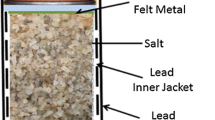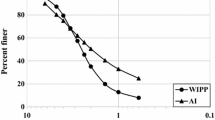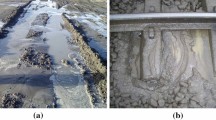Abstract
Understanding the consolidation behavior of granular salt is of great significance for salt cavern repository design and the corresponding long-term safety assessments. To evaluate the influence of environmental and geological factors on the reconsolidation behavior of fine granular salt, a series of orthogonal array design experiments were performed. The experimental results showed that temperature, compressive stress, moisture content and compression time had significant impacts on the compaction properties of granular salt. The compressive stress exerted the greatest impact on porosity of the granular salt, which decreased the porosity. An increase in moisture content (within 3%) in the granular salt sample substantially reduced the porosity of the sample, whereas this effect was limited when moisture exceeded 3%. In the process of granular salt compaction, all of the deformation mechanisms were temperature dependent. The correlation between porosity and permeability of the dried compacted salt samples was independent of the environmental and geological factors during the compaction of the granular salt. The use of granular salt with a smaller particle size in the compacted salt backfill can improve its sealing performance. In the transient loading stage of granular salt compaction, the porosity decreased rapidly under stress to form a denser layer, which was mainly accomplished by particle rearrangement and cataclastic flow. However, in the constant-load creep stage, the additional porosity reduction was dominated by grain boundary processes and crystal plasticity mechanisms, including dislocation creep, pressure-solution creep and recrystallization.















Similar content being viewed by others
References
Arson, C. (2020). Micro-macro mechanics of damage and healing in rocks. Open Geomechanics, 2, 1–41.
Arson, C., Xu, H., & Chester, F. M. (2012). On the definition of damage in time-dependent healing models for salt rock. Géotechnique Letters, 2(2), 67–71.
Bauer, S., & Urquhart, A. (2016). Thermal and physical properties of reconsolidated crushed rock salt as a function of porosity and temperature. Acta Geotechnica, 11(4), 913–924.
Bechthold, W., Smailos, E., Heusermann, S., Bollingerfehr, W., Bazargan Sabet, B., Rothfuchs, T., et al. (2004). Backfilling and sealing of underground repositories for radioactive waste in salt (BAMBUS-II Project). Final report for European atomic energy community EUR 20621. Luxembourg: Office for Official Publications of the European Communities.
Broome, S., Bauer, S., & Hansen, F. (2014). Reconsolidation of crushed salt to 250°C under hydrostatic and shear stress conditions. In 48th US rock mechanics/geomechanics symposium, June 1–4, 2014, Minneapolis, Minnesota.
Chan, K. S., Bodner, S. R., & Munson, D. E. (2001). Permeability of WIPP salt during damage evolution and healing. International Journal of Damage Mechanics, 10(3), 347–375.
Chan, K. S., Bodner, S. R., Munson, D. E., & Munson, D. E. (2000). Application of isochronous healing curves in predicting damage evolution in a salt structure. International Journal of Damage Mechanics, 9(2), 130–153.
Chen, J., Kang, Y., Liu, W., Fan, J., Jiang, D., & Chemenda, A. (2018). Self-healing capacity of damaged rock salt with different initial damage. Geomechanics and Engineering, 15(1), 615–620.
Chen, J., Liu, W., Jiang, D., Zhang, J., Ren, S., Li, L., et al. (2017). Preliminary investigation on the feasibility of a clean CAES system coupled with wind and solar energy in China. Energy, 127, 462–478.
Chen, J., Lu, D., Liu, W., Fan, J., Jiang, D., Yi, L., et al. (2020). Stability study and optimization design of small-spacing two-well (SSTW) salt caverns for natural gas storages. Journal of Energy Storage. https://doi.org/10.1016/j.est.2019.101131.
Chen, J., Ren, S., Yang, C., Jiang, D., & Li, L. (2013). Self-healing characteristics of damaged rock salt under different healing conditions. Materials, 6(8), 3438–3450.
Cinar, Y., Pusch, G., & Reitenbach, V. (2006). Petrophysical and capillary properties of compacted salt. Transport in Porous Media, 64(2), 199–228.
Costa, A., Amaral, C., & Poiate, E., Jr. (2015). Hydrocarbon production and storage using offshore underground salt caverns. In L. Roberts, K. Mellegard, & F. Hansen (Eds.), Mechanical behaviour of salt VIII (pp. 209–216). London: Taylor & Francis Group.
Cretì, A. (2009). The economics of natural gas storage: A European perspective. Berlin: Springer.
Desbois, G., Urai, J. L., Schmatz, J., Zavada, P., & de Bresser, H. (2012). The distribution of fluids in natural rock salt to understand deformation mechanisms. In P. Berest, M. Ghoreychi, F. Hadj-Hassen, & M. Tijani (Eds.), Mechanical behavior of salt VII (pp. 3–12). London: Taylor & Francis Group.
Dewers, T., Heath, J. E., & Leigh, C. D. (2015). Transport properties of run-of-mine salt backfill? Unconsolidated to consolidated. In No. SAND2015-8677R. Albuquerque, NM: Sandia National Lab.
Ding, J., Chester, F. M., Chester, J. S., Zhu, C., & Arson, C. (2016). Mechanical behavior and microstructure development in consolidation of nominally dry granular salt. In 50th US rock mechanics/geomechanics symposium, June 26–29, 2016, Houston, Texas.
Fan, J., Jiang, D., Chen, J., Liu, W., Ngaha, W. T., & Chen, J. (2018). Fatigue performance of ordinary concrete under discontinuous cyclic loading. Construction and Building Materials, 166, 974–981.
Fan, J., Jiang, D., Liu, W., Wu, F., Chen, J., & Daemen, J. (2019). Discontinuous fatigue of salt rock with low-stress intervals. International Journal of Rock Mechanics and Mining Sciences, 115, 77–86.
Fan, J., Liu, W., Jiang, D., Chen, J., Tiedeu, W. N., & Daemen, J. J. (2020a). Time interval effect in triaxial discontinuous cyclic compression tests and simulations for the residual stress in rock salt. Rock Mech Rock Eng. https://doi.org/10.1007/s00603-020-02150-y.
Fan, J., Liu, P., & Li, J. (2020b). A coupled methane/air flow model for coal gas drainage: model development and finite-difference solution. Process Safety and Environmental Protection, 141(8), 288–304.
Firme, P. A., Roehl, D., & Romanel, C. (2016). An assessment of the creep behaviour of Brazilian salt rocks using the multi-mechanism deformation model. Acta Geotechnica, 11(6), 1445–1463.
Hansen, F. D. (2014). Micromechanics of isochoric salt deformation. In 48th US rock mechanics/geomechanics symposium, June 1–4, 2014, Minneapolis, Minnesota
Hansen, F. D., Bauer, S., Broome, S., & Callahan, G. (2012). Coupled thermal-hydrological-mechanical processes in salt: Hot granular salt consolidation, constitutive model and micromechanics. In No. SAND2012-9893P. Albuquerque, NM: Sandia National Laboratories.
Hansen, F. D., & Leigh, C. D. (2011). Salt disposal of heat-generating nuclear waste. In No. SAND2011-0161. Albuquerque, NM: Sandia National Laboratories.
Hansen, F. D., Popp, T., Wieczorek, K., & Stuehrenberg, D. (2014). Granular salt summary: Salt reconsolidation principles and application. In No. SAND2014-16141R. Albuquerque, NM: Sandia National Laboratories.
Hart, D. (2018). An analysis of possible salt fall events in historical pressure data from the US strategic petroleum reserve. In No. SAND-2018-11419. Albuquerque, NM: Sandia National Lab.
Houben, M. E., ten Hove, A., Peach, C. J., & Spiers, C. J. (2013). Crack healing in rocksalt via diffusion in adsorbed aqueous films: microphysical modelling versus experiments. Physics and Chemistry of the Earth, Parts A/B/C, 64, 95–104.
Jiang, D., Fan, J., Chen, J., Li, L., & Cui, Y. (2016). A mechanism of fatigue in salt under discontinuous cycle loading. International Journal of Rock Mechanics and Mining Sciences, 100(86), 255–260.
Kang, Y., Chen, J., Jiang, D., Liu, W., & Fan, J. (2019). Summary on damage self-healing property of rock salt. Rock and Soil Mechanics, 40(1), 55–69.
Khamrat, S., & Fuenkajorn, K. (2018). Mechanical performance of consolidated crushed salt as backfill in boreholes and shafts. Songklanakarin Journal of Science and Technology, 40(2), 431–439.
Khamrat, S., Tepnarong, P., Artkhonghan, K., & Fuenkajorn, K. (2018). Crushed salt consolidation for borehole sealing in potash mines. Geotechnical and Geological Engineering, 36(1), 49–62.
Lampe, B. C., Stormont, J. C., Lynn, T. D., & Bauer, S. J. (2018). Experimental investigation of the influence of pore pressure and porosity on the deformation of granular salt. International Journal of Rock Mechanics and Mining Sciences, 110, 291–305.
Letcher, T. M. (2019). Storing electrical energy. In T. M. Letcher (Ed.), Managing global warming: An interface of technology and human issues (pp. 365–377). Amsterdam: Elsevier.
Li, J., Shi, X., & Zhang, S. (2020). Construction modeling and parameter optimization of multi-step horizontal energy storage salt caverns. Energy. https://doi.org/10.1016/j.energy.2020.117840.
Liu, W., Chen, J., Jiang, D., Shi, X., Li, Y., Daemen, J. J. K., et al. (2016). Tightness and suitability evaluation of abandoned salt caverns served as hydrocarbon energies storage under adverse geological conditions (AGC). Applied Energy, 178, 703–720.
Liu, E., Li, W., Cai, H., & Peng, S. (2019a). Formation mechanism of trailing oil in product oil pipeline. Processes, 7(1), 7.
Liu, W., Li, Y., Yang, C., Daemen, J. J., Yang, Y., & Zhang, G. (2015). Permeability characteristics of mudstone cap rock and interlayers in bedded salt formations and tightness assessment for underground gas storage caverns. Engineering Geology, 193, 212–223.
Liu, E., Lv, L., Yi, Y., & Xie, P. (2019b). Research on the steady operation optimization model of natural gas pipeline considering the combined operation of air coolers and compressors. IEEE Access, 7, 83251–83265.
Liu, W., Zhang, Z., Chen, J., Fan, J., Jiang, D., Jjk, D., et al. (2019c). Physical simulation of construction and control of two butted-well horizontal cavern energy storage using large molded rock salt specimens. Energy, 185, 682–694.
Liu, W., Zhang, X., Fan, J., Li, Y., & Wang, L. (2020). Evaluation of potential for salt cavern gas storage and integration of brine extraction: Cavern utilization, Yangtze River Delta region. Natural Resources Research. https://doi.org/10.1007/s11053-020-09640-4.
Mills, M. M., Stormont, J. C., & Bauer, S. J. (2018). Micromechanical processes in consolidated granular salt. Engineering Geology, 239, 206–213.
Olivella, S., Castagna, S., Alonso, E., & Lloret, A. (2011). Porosity variations in saline media induced by temperature gradients: Experimental evidences and modelling. Transport in Porous Media, 90(3), 763–777.
Paneru, L. P., Bauer, S. J., & Stormont, J. C. (2018). Thermal properties of consolidated granular salt as a backfill material. Rock Mechanics and Rock Engineering, 51(3), 911–923.
Peach, C. J., Spiers, C. J., & Trimby, P. W. (2001). Effect of confining pressure on dilatation, recrystallization and flow of rocksalt at 150°C. Journal of Geophysical Research Solid Earth, 106(B7), 13315–13328.
Peng, H., Fan, J., Zhang, X., Chen, J., Li, Z., Jiang, D., et al. (2020). Computed tomography analysis on cyclic fatigue and damage properties of rock salt under gas pressure. International Journal of Fatigue. https://doi.org/10.1016/j.ijfatigue.2020.105523.
Piazolo, S., Bestmann, M., Prior, D., & Spiers, C. (2006). Temperature dependent grain boundary migration in deformed-then-annealed material: Observations from experimentally deformed synthetic rocksalt. Tectonophysics, 427(1–4), 55–71.
Popp, T., Minkley, W., Salzer, K., & Schulze, O. (2012). Gas transport properties of rock salt–synoptic view. In P. Berest, M. Ghoreychi, F. Hadj-Hassen, & M. Tijani (Eds.), Mechanical behavior of salt VII (pp. 143–153). London: Taylor & Francis Group.
Qiao, W., Yang, Z., Kang, Z., & Pan, Z. (2020). Short-term natural gas consumption prediction based on Volterra adaptive filter and improved whale optimization algorithm. Engineering Applications of Artificial Intelligence. https://doi.org/10.1016/j.engappai.2019.103323.
Salzer, K., Popp, T., & Böhnel, H. (2007). Mechanical and permeability properties of highly pre-compacted granular salt bricks. In K.-H. Lux, W. Minkley, M. Wallner, & H. R. Hardy Jr. (Eds.), Basic and applied salt mechanics: Proceedings of the 6th conference on the mechanical behavior of salt (pp. 239–248). Hannover: Francis & Taylor.
Schenk, O., & Urai, J. L. (2004). Microstructural evolution and grain boundary structure during static recrystallization in synthetic polycrystals of sodium chloride containing saturated brine. Contributions to Mineralogy and Petrology, 146(6), 671–682.
Schenk, O., Urai, J. L., & Piazolo, S. (2006). Structure of grain boundaries in wet, synthetic polycrystalline, statically recrystallizing halite—evidence from cryo-SEM observations. Geofluids, 6(1), 93–104.
Schiebahn, S., Grube, T., Robinius, M., Tietze, V., Kumar, B., & Stolten, D. (2015). Power to gas: Technological overview, systems analysis and economic assessment for a case study in Germany. International Journal of Hydrogen Energy, 40(12), 4285–4294.
Shen, X., & Arson, C. (2019a). An isotropic self-consistent homogenization scheme for chemo-mechanical healing driven by pressure solution in halite. International Journal of Solids and Structures, 161, 96–110.
Shen, X., & Arson, C. (2019b). Simulation of salt-cavity healing based on a micro–macro model of pressure solution. Petroleum Geoscience, 25(3), 251–257.
Shi, X., Li, Y., Yang, C., Xu, Y., Ma, H., Liu, W., et al. (2015). Influences of filling abandoned salt caverns with alkali wastes on surface subsidence. Environmental Earth Sciences, 73(11), 6939–6950.
Spiers, C. J., & Schutjens, P. M. T. M. (1999). Intergranular pressure solution in Nacl: Grain-to-grain contact experiments under the optical microscope dissolution sous contrainte dans NaCl: Expériences de contact grain à grain sous microscope optique. Oil & Gas Science & Technology, 54(6), 729–750.
Tarkowski, R., & Czapowski, G. (2018). Salt domes in Poland-potential sites for hydrogen storage in caverns. International Journal of Hydrogen Energy, 43(46), 21414–21427.
Ter Heege, J. H., De Bresser, J., & Spiers, C. (2005a). Rheological behaviour of synthetic rocksalt: the interplay between water, dynamic recrystallization and deformation mechanisms. Journal of Structural Geology, 27(6), 948–963.
Ter Heege, J. H., De Bresser, J. H. P., & Spiers, C. J. (2005b). Dynamic recrystallization of wet synthetic polycrystalline halite: dependence of grain size distribution on flow stress, temperature and strain. Tectonophysics, 396(1–2), 35–57.
Urai, J. L., Schléder, Z., Spiers, C., & Kukla, P. (2008). Flow and transport properties of salt rocks. In R. Littke, U. Bayer, D. Gajewski, & S. Nelskamp (Eds.), Dynamics of complex intracontinental basins: the central European basin system (pp. 277–290). Berlin: Springer.
Urai, J. L., & Spiers, C. (2007). The effect of grain boundary water on deformation mechanisms and rheology of rocksalt during long-term deformation. In M. Wallner, K.-H. Lux, W. Minkley, & H. Hardy (Eds.), The mechanical behaviour of salt—understanding of THMC processes in salt (pp. 149–158). London: Taylor & Francis.
Urai, J. L., Spiers, C., Zwart, H. J., & Lister, G. S. (1986). Weakening of rock salt by water during long-term creep. Nature, 324(6097), 554–557.
Wang, J., Zhang, Q., Song, Z., & Zhang, Y. (2020). Creep properties and damage constitutive model of salt rock under uniaxial compression. International Journal of Damage Mechanics, 29(6), 902–922.
Wu, F., Gao, R., Liu, J., & Li, C. (2020). New fractional variable-order creep model with short memory. Applied Mathematics and Computation. https://doi.org/10.1016/j.amc.2020.125278.
Zhang, N., Shi, X., Zhang, Y., & Shan, P. (2020). Tightness analysis of underground natural gas and oil storage caverns with limit pillar widths in bedded rock salt. IEEE Access, 8, 12130–12145.
Zhu, C., & Arson, C. (2015a). Fabric-enriched modeling of anisotropic healing induced by diffusion in granular salt. In The 49th US rock mechanics/geomechanics symposium, 28 June–1 July 2015, San Francisco, CA.
Zhu, C., & Arson, C. (2015b). A model of damage and healing coupling halite thermo-mechanical behavior to microstructure evolution. Geotechnical and Geological Engineering, 33(2), 389–410.
Acknowledgments
This work was supported by the National Natural Science Foundation of China (Nos. 51834003, 41672292, 51904039, 41702309) and Chongqing Postdoctoral Science Foundation (cstc2019jcyj-bshX0084), which are all greatly appreciated.
Author information
Authors and Affiliations
Corresponding author
Rights and permissions
About this article
Cite this article
Kang, Y., Fan, J., Jiang, D. et al. Influence of Geological and Environmental Factors on the Reconsolidation Behavior of Fine Granular Salt. Nat Resour Res 30, 805–826 (2021). https://doi.org/10.1007/s11053-020-09732-1
Received:
Accepted:
Published:
Issue Date:
DOI: https://doi.org/10.1007/s11053-020-09732-1




